Operation "Sturgeon Fishing". To the 70 anniversary of the fall of Sevastopol. 2 part
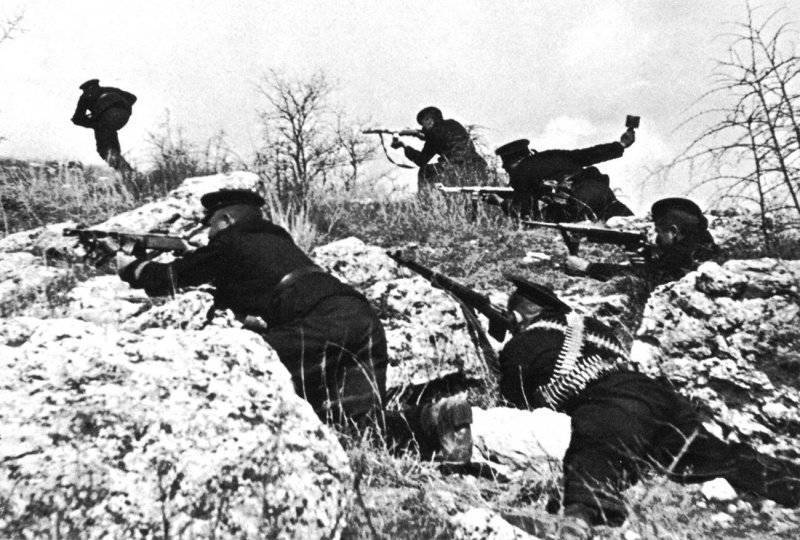
On the morning of June 7, 1942 at 4.00, artillery preparations began before the immediate German offensive. The power of artillery shelling is evidenced by the fact that only the 600-mm "Odin" and "Tor" fired 54 shells that day. At the position of the 172nd Infantry Division and the 79th Marine Rifle Brigade, about 14,5 thousand shells fell. The help of the 8th German aviation corps expressed itself not only in constant raids aviation, but also in saturating the battle formations of the infantry with anti-aircraft artillery. To support the offensive of the LIV Army Corps (it attacked the 4th and 3rd sectors of the Sevastopol Defensive Region), an anti-aircraft artillery battle group was created under the command of Major Miller consisting of twelve 88-mm, nine 37-mm and thirty 20- mm anti-aircraft guns. Anti-aircraft artillery participated in artillery preparation, then fired on bunkers, the positions of Soviet artillery and other fortifications.
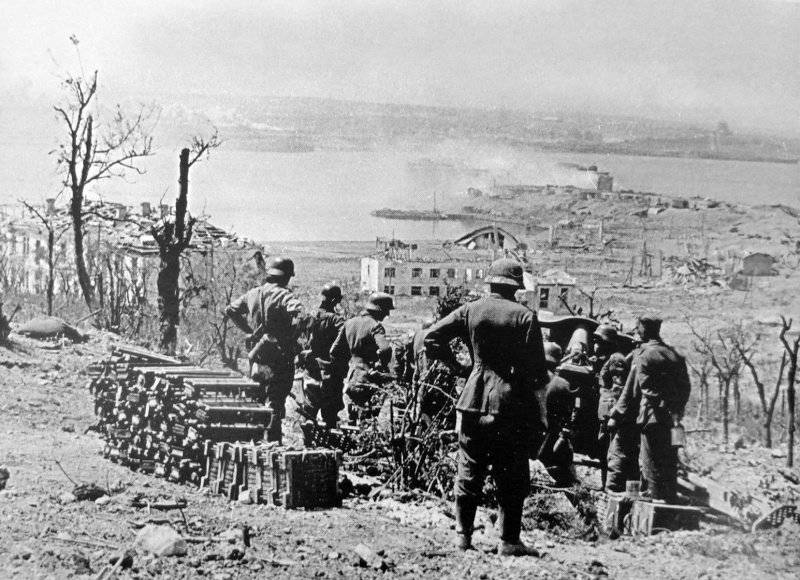
The calculation of the German howitzer 10,5 cm leFH18 is shelling Konstantinovsky fort, which protected the entrance to the Sevastopol Bay. The Germans launched an assault on this fort in the morning of June 22, 1942. The last defenders of the fort crossed over to the south side of the city in the early morning of June 24.
After a powerful aviation and artillery preparation, the German assault groups, hiding behind a firing shaft, went on the attack. The defense of Sora conditionally divided in half the North Bay. The plan of the German command was to first destroy the Soviet defenses in the 3 and 4 sectors (on the northern side), go to the bay, and then send the newly released units to the southern part of the city. Therefore, the LIV-Corps as part of the 22, 24, 50 and 132 infantry divisions were the first to attack the Soviet positions. The German corps was to destroy the Soviet defenses on the northern shore of the bay and create a bridgehead on its southern shore, in the rear of the 1 and 2 sectors of defense.
On the first day of the battle, the German troops managed only to wedge in the location of the COP in one place - at the junction of the 3-th and 4-th sectors (between the positions of the 79-th naval rifle brigade and the 172-th rifle division). At the cost of heavy casualties, the German attackers managed to reach the Mekenziy heights (mountains) line during 7 and 8 June. On the third day of the battle, the German command brought into battle the second echelon of the LIV Corps, the 24 Infantry Division.
On June 10, the XXX Army Corps joined the offensive. It consisted of three divisions: the 28th light infantry division, the 72nd and 170th infantry divisions. In the offensive zone of the 30th Corps tank battalion of the 22nd Panzer Division. Tanks were used in small groups of 3-10 vehicles as a means of direct support for infantry. Several captured Soviet tanks, KV, also participated in the offensive. However, in this direction of the offensive, the Germans failed to achieve great success. By June 18, German troops were able to push the formations of the 1st and 2nd SOR sectors to the second line of defense.
With the beginning of the assault, the Soviet command began to send reinforcements to the city. On the night of June 10 arrived transport "Abkhazia", accompanied by the destroyer "Free". However, participation in the storming of a powerful German air force made the transfer of troops and supplies deadly. Already in the afternoon of June 10 both ships were sunk by German aircraft. In the late evening of June 12, the cruiser “Molotov” and the destroyer “Vigilant” arrived from Novorossiysk. They delivered the 138 th rifle brigade under the command of Major MM Zelin (2,6 thousand fighters with sixteen 76-mm and twelve 45-mm guns, eight 120-mm mortars). The brigade was immediately thrown into battle - it went to the counterattack at the junction of the 3 and 4 sectors of the COP. On the afternoon of June 13, the cruiser and destroyer fired from the North Bay at the advancing German forces. For a short time, the defenders of Sevastopol were able to restore the balance and repel the Mekenziev heights. Then, taking over 1 thousand wounded and 350 women and children, "Molotov" and "Vigilant" went to Novorossiysk.
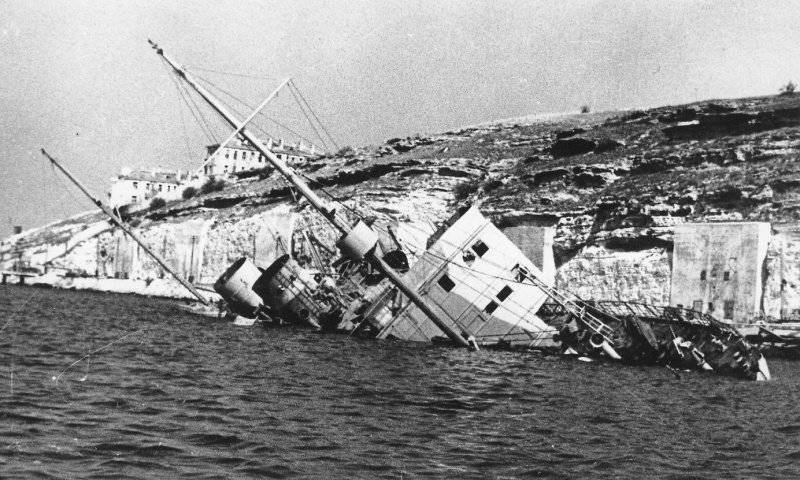
The Soviet ambulance transport "Abkhazia" sunk in Sukharnaya gully of Sevastopol. The vessel was sunk by 10.06.1942 as a result of a German airstrike bomb hit the stern. The destroyer "Free" was also sunk, in which 9 bombs fell.
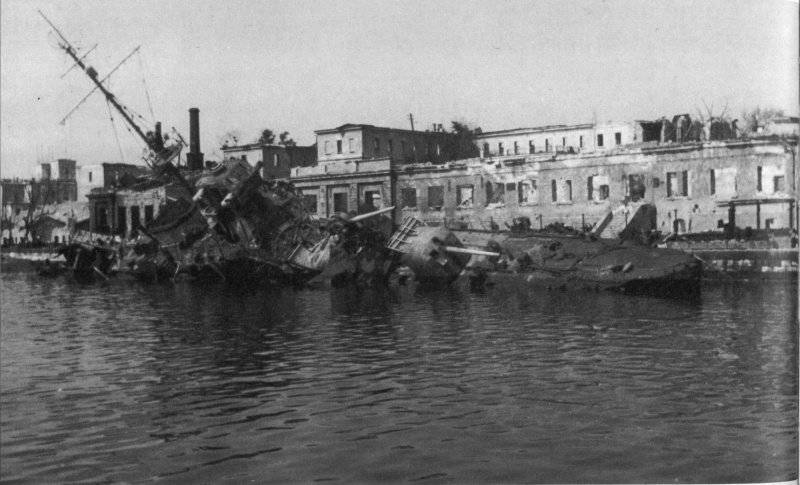
The destroyer of the 7U “Svobodnyy” project, sunk on 10 on June 1942, by German dive bombers of the VIIIth air corps, General V. von Richthofen in the Ship Bay of Sevastopol.
On June 12-13, the German command regrouped its forces. On June 14, the assault resumed with renewed vigor. On the same day, German aircraft sank the transport "Georgia" with 526 tons of ammunition and marching replenishment of 708 people. The death of "Abkhazia" and "Georgia" led to a lack of ammunition. Guaranteed to break through the blockade of the city could only submarines and high-speed ships with strong anti-aircraft weapons. On the night of June 16, Molotov and Vigilant arrived in Sevastopol again. They unloaded more than 400 tons of ammunition, food, various property and more than 3 thousand reinforcements. The cruiser fired at enemy positions, took on board 1625 wounded and 382 evacuated, and on the 17th arrived safely in Novorossiysk. In addition, Black Sea submarines arrived every day in the city. fleet.
On June 12, General Erich von Manstein requested a replenishment of three regiments from the command of Army Group South. On June 14, the commander of the 11 Army raised the request to the 4 regiments. June 16 the first of the requested regiments was sent to the army of Manstein. 18 June German troops broke through to the North Bay.
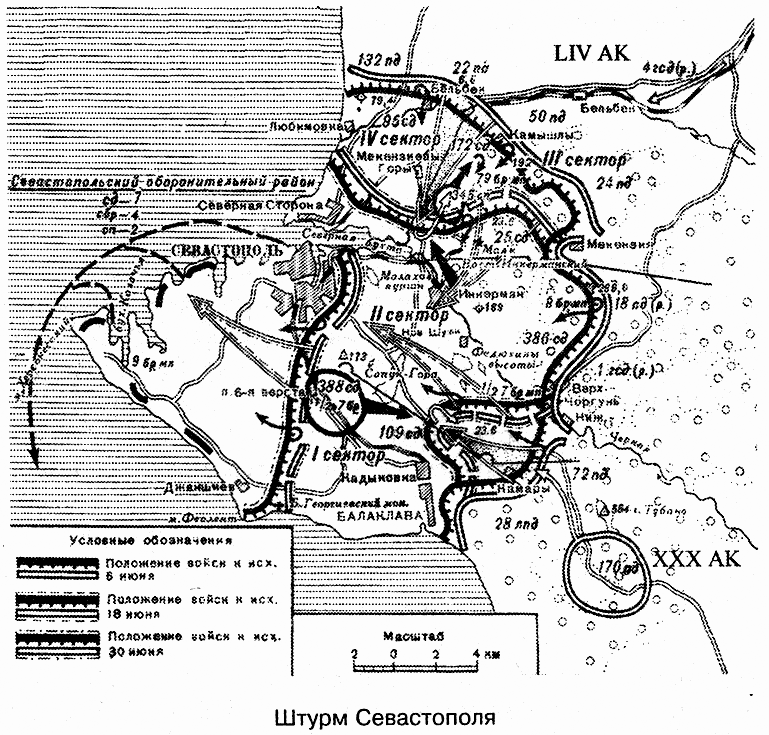
Drop armored battery-30
As of 30 in May 1942, the personnel of the battery-30 consisted of 22 commanders and 342 red sailors. 6 June 1942 The Germans used heavy duty guns to attack the battery - two 600-mm Karl type mortars. The enemy managed to incapacitate the second tower, armor was pierced in it and one weapon was damaged. On the same day, German aviation dropped 30-kg bombs to the position of the battery-1000. On the night of June 7, the workforce brigade team led by Brigadier S. I. Prokuda and the battery garrison was put into operation, but could only operate with one weapon. 7 June Two 600-mm shells hit the first turret.
During June 9 and 10, the 30 battery fired according to the battle formations of the advancing German infantry, armored vehicles and artillery positions of the enemy, which entered the battle formations of the defending Soviet forces in the sector of the 4. By June 10, the coastal battery could fire only with two guns, one gun in each tower. The ground defense structures of the 30 battery were almost completely destroyed and inundated. June 11 Soviet troops tried to improve the position of the battery to eliminate the breakthrough of the forces of the enemy.
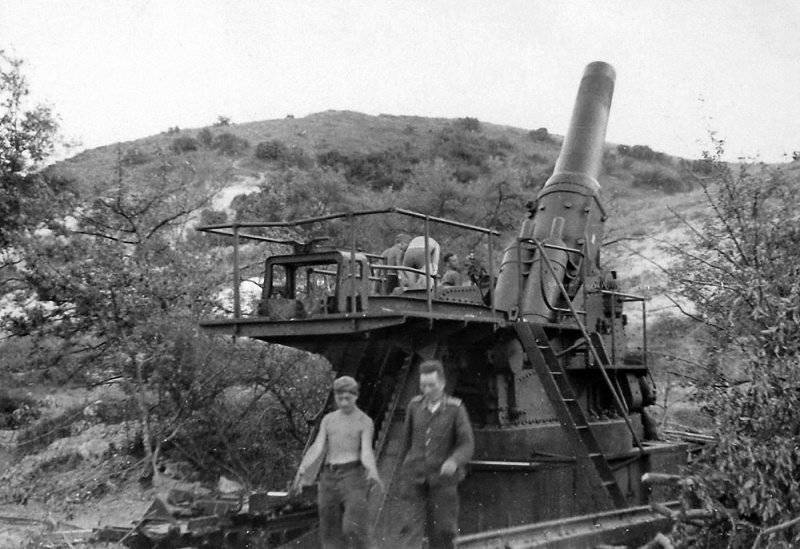
420-mm mortar "Gamma".
The Germans did their best to eliminate the 30 coastal battery, and fired it with heavy guns every day. So, only 14 June enemy artillery fired on the 30 battery over 700 projectiles. German planes bombed it with bitterness, but did not succeed, although the 15 of June on the battery was made before the 600 air raids. 15 – 17 June by the Germans with forces from two to four regiments, supported by armored vehicles, launched an offensive, planning to capture Budenovka village and surround the coastal battery No. XXUMX. At the same time, a group of German soldiers who broke through 30 in June into the area of the Sofia Perovskoy state farm destroyed the battery communication lines with the city. 15 June radio communication also stopped working, since during the battle all antennas were destroyed.
June 17 armored battery-30 was finally surrounded by German troops. In the premises of the fortified area, there remained about 250 a man of personnel and soldiers of the 95 th infantry division, marines. In accordance with the orders of the command, in case of blocking the battery by the enemy, the garrison had to break out of the encirclement of three troops, the latter had to blow up the position. The first squadron in the number of 76 fighters led by the instructor of the coastal defense political department Kalinkin went on to break the ring. Part of the group died, but part of the squad managed to break through and report to the command about the situation on the battery. The rest is delayed with the exit. As a result, the enemy, having detected the release of the first detachment, strengthened measures to blockade the positions of the battery and a new breakthrough became impossible without external assistance. At a meeting with Vice-Admiral Philip Sergeevich Oktyabrsky (Commander of the Black Sea Fleet and one of the leaders of the defense of Sevastopol), a proposal was made to try to break through the blockade of the 30 battery to free up the garrison remnants and undermine the battery. June 18 Soviet troops attempted to unlock the battery. But this attempt was unsuccessful. The Germans successfully used artillery and aircraft and simultaneously resumed the offensive. On the night of June 18, the garrison attempted to break through to its troops, but the Germans beat it back.
German units destroyed wire barriers and minefields. The funnels, which were formed as a result of the explosions of bombs, shells and mines, facilitated the German offensive. The garrison of the outer defensive ring was mostly destroyed, and its light defenses were destroyed. June 18 guns made their last shots and were disabled by the hits of German shells. All external fortifications were captured or destroyed. German sappers were able to get close to the first armored turret installation and throw grenades at its garrison. The remains of the garrison battery settled in the underground premises of the second tower.
In the following days, the Germans tried to smoke the last defenders of the 30 battery out of the premises using explosive charges, flammable oils and gasoline. As a result of explosions in the tower installations, strong fires began and the rooms were filled with smoke. On June 25, battery commander Major George Alexander with a group of fighters passed through a drain to the Belbek River and tried to break through to the partisans. However, the next day, in the area of the village of Duvanka (now Verkhnaya Garden), the group was discovered and captured by the Germans. Alexander was identified and shot. 26 June, the German assault group made its way inside the block and captured the remnants of the garrison - 40 man.
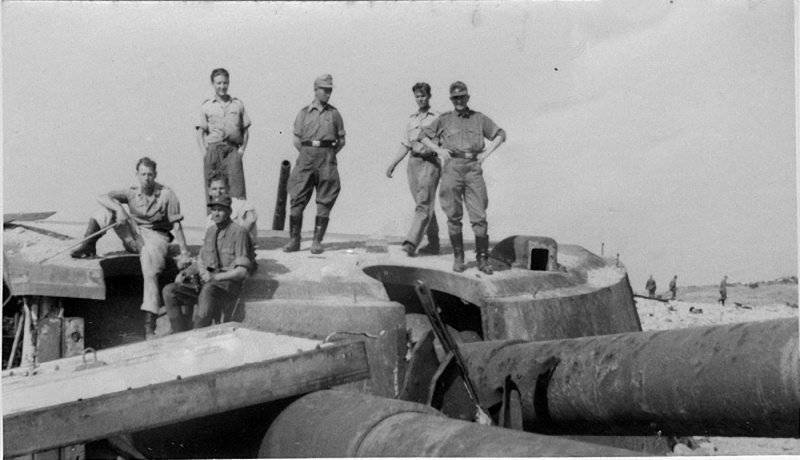
German soldiers on the destroyed tower number XXUMX (western) 2-th coastal battery of Sevastopol.
Further events
Manstein again requested reinforcements. To replenish the troops storming Sevastopol, units were sent from the 371 Infantry Division, which arrived in the Caucasus to participate in the summer offensive.
A new attempt to break the blockade of Sevastopol 18 June with the help of transport ended tragically. Transport "Bialystok" on the way back was sunk by a German torpedo boat. As a result, the supply of the Sevastopol defensive area by sea during 13-20 June provided only a replenishment of 20% of personnel losses and about a third of the ammunition expenditure. In June, the Black Sea Fleet delivered more than 21 thousand people to the city, more than 5,5 thousand tons of ammunition, took out about 19 thousand wounded people and 15 thousand local residents from Sevastopol. Submarines delivered more than 2,2 thousand tons of ammunition, over 1 thousand tons of food, 534 tons of gasoline to Sevastopol, and 1303 took the wounded and residents out of the city.
Realizing that the situation is critical, the Soviet command tried again to use the same technique, which brought success in December 1941. In the evening of June 19, by directive of the Supreme High Command Headquarters, the North Caucasus Front was ordered to prepare a landing operation to capture the Kerch Peninsula. It was assumed landing airborne and sea landing in the area of Kerch. In the first echelon, they planned to land the 32 th guards rifle division and three battalions of marines. But there is no time left for the concentration of forces and means, the organization of the landing. A few days later it became clear that Sevastopol was doomed.
23 June 1942 of the year, on the orders of the COM command, the remnants of the forces of the 4 sector retreated to the south coast of the North Bay. On the same day, the “blue cruiser” “Tashkent” (the leader of destroyers) and the destroyer “Impeccable” broke through into Sevastopol. They brought part of the 142 th infantry brigade and its weapons. In the evening of June 26 “Tashkent” arrived in the city for the last time. He brought units and weapon 142 Brigade and took on the 2300 wounded and local residents. The return of the “blue cruiser” (it was painted in bluish color) to Novorossiysk speaks about the difficulty of breaking through to the city and leaving it. Starting from 5 hours of the morning up to 9 hours, the cruiser was subjected to continuous attacks by enemy aircraft (about 90 vehicles took part in them). More than 300 bombs were dropped on the ship. The ship received several serious damage, spent all anti-aircraft ammunition. Only thanks to the dedication of the crew and help from Novorossiysk the ship was able to bring to the port. Campaign "Tashkent" was the last attempt to break through the blockade of Sevastopol large surface ships.
On the night from 28 to June 29, without artillery preparation, under the cover of a smoke screen, parts of the 22 and 24 infantry divisions forced North Bay into inflatable boats and entrenched on its southern coast. On the morning of the same day, after the most powerful hour and a half of artillery and aviation training, the Germans delivered a strong blow from the Fedyukhnyh heights and Novaya Shuli in the north-west direction and on Sapun gora. The defense of the troops of the 2 sector of the SOR was broken.
Early in the morning of June 30, Admiral Oktyabrsky addressed Semyon Mikhailovich Budyonny (commander of the North Caucasus Front) with a report in which he said that the defense of the COP would last another 2-3 of the day. He requested permission for the evacuation by airplanes of the commanding and political staff of the remnants of the Maritime Army. Budyonny sent a report to Moscow, and also offered to take out all that is possible and stop the supply of reinforcements. The command of the Sevastopol Defense Region prepared a preliminary list of evacuation: from the Black Sea Fleet - 77 people, from the Maritime Army - 78 people. The highest command structure from the regiment commander and higher officials of the city were subject to evacuation. BGK has given permission to evacuate.
In the evening of June 30, the last meeting of the Military Councils of the Black Sea Fleet and the Maritime Army was held in the casemate of the armored battery No. 35. A backup flagship command post was created on the 35 battery, and an additional communications center was also deployed. On the night of June 29, the naval fleet, led by Vice Admiral FS, arrived at the coastal battery. October. Somewhat later, the leadership and the headquarters of the Maritime Army and the Coastal Defense fleet moved to the battery. At the last meeting, it was decided to evacuate the command of SOR, the navy and the Primorsk army. The commandant of the 35 battery, captain A. Ya. Leshchenko, was ordered to blow up the battery after the last shells had been spent. To coordinate the actions of the last defending units in Sevastopol, the commander of the 109 Infantry Division P. G. Novikov was left (he was captured and killed in a German concentration camp in 1944 year).
The Last Days
The defense system of Sevastopol collapsed. In the afternoon of June 30 the fleet command and control post was shut down. The equipment of the two radar stations was dropped into the sea. The remnants of the Aviation Aviation flew from Chersonesus to Anapa.
It should be noted that the export of high command has become a complex moral and psychological problem, both for evacuees and for subordinates. The removal of senior commanders finally demoralized a significant part of the garrison. People felt not only doomed, but also betrayed. Therefore, already 1 July existed only separate centers of resistance, there was no solid line of defense.
There was no secret flight. The evacuation process went publicly. In the evening of June 30, transport aircraft began to land on the Chersonesus airfield. At the airfield at that moment there was a mass of unorganized soldiers with commanders. There were cases when planes were taken by storm. Total 30 June flew 13 transport aircraft, they took 232 man, including October. Landing on submarines was more organized. But here it was not without incident. From the crowd, not only a scolding was heard, but an automatic burst sounded. She got into the head of the staffing department of the Maritime Army Semechkin who was walking in front of Ivan Petrov. Unable to withstand the psychological pressure, the chief of staff of the coastal defense, I. F. Kobalyuk, returned and said that he would die with his subordinates. Submarines L-23 and W-209 removed 180 people.
The worst was the fate of the wounded. From 21 May to 3 July, COP lost thousands more than 55 to injured people. During the same period, 18,7 thousands of injured were evacuated. As a result, more than 35 thousand wounded remained in the city. Those who could move independently began to gather in the evening of June 30 in the bays of Kamyshovaya and Kazachye in the hope of evacuation. In addition to airplanes and submarines, minesweepers, patrol ships, boats and light watercraft were used to transport people. But the attempt to take out 2 thousand on the night of 2 in July failed as a whole, the ships were those who could reach them. More than 500 command personnel and 1116 junior command personnel and soldiers were taken to the Caucasus coast. Part of trying to sail on improvised rafts was destroyed by German aircraft, torpedo boats, or taken prisoner.
A part of the defenders of SOR managed to break into the mountains and joined the partisans. Armor-resistant battery-35 has become one of the last pockets of resistance. 1 July coastal battery has undergone a powerful raid of German aircraft and artillery shelling. During the day, the battery-35 shot the remnants of ammunition, firing practical shells (battle ended) on German tanks at Cape Fiolent, and shrapnel shells on enemy infantry in the reed beam area. It should be noted that at Cape Fiolent, a regiment of border guards pressed to the sea under the command of Colonel Rubtsov and battalion commissar Smirnov fought. Rubtsov received Novikov's order to break through to the 35 battery. From the frontier guards and fighters and commanders from other units and subunits who found themselves in the vicinity of Cape Fiolent on July 1, a combined regiment was created. They could not get through to the battery. The wounded in this attack, Colonel G. A. Rubtsov and Commissioner A. P. Smirnov, were shot to avoid being taken prisoner.
Almost all personnel of the 35 battery fought on the positions of the outer ring of defense. On the night of July 1, a group of German attack aircraft made their way to the battery area between the tower blocks and the right command post. The battery commander A. Ya. Leshchenko ordered the destruction of all equipment and firing controls and the retreat into the battery array. In 0 hours 35 minutes 2 July with the permission of Major General P.G. Novikov garrison blew up the ammunition cellars and the first tower. Then, after the destruction of communications equipment, equipment and firing controls at 2.30, the second tower was destroyed. The commander of the battery part of the staff were able to evacuate to the Caucasus. But the defense of the underground premises continued until July 12, then those who did not want to surrender fought.
4 July 1942, after artillery preparation, German infantry supported by tanks broke into Chersonesus Cape. The last line of defense collapsed, and the mass captivity of the surviving defenders of Sevastopol began.
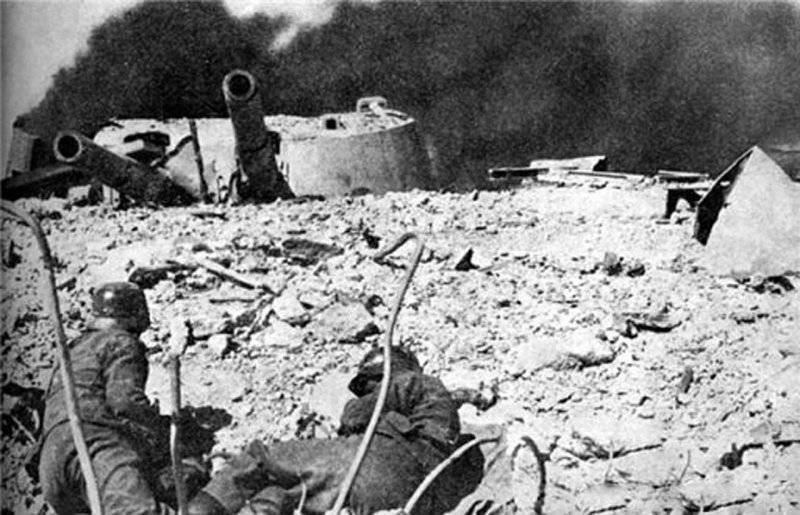
German soldiers in battle in the 35-th battery of Sevastopol.
Results
- 250-day defense of Sevastopol is completed. Hero City has fallen. According to the Germans, about 100 of thousands of prisoners were captured, according to Soviet information - about 62,8 thousand of people were missing.
- The Germans eliminated a large Soviet bridgehead in the Crimea, which chained considerable forces to itself. The XXX Corps was soon sent under Leningrad, and the LIVth Corps was planned to be used in the Caucasus.
- The SORA assault showed that passive defense (even with a large garrison, strong positions) cannot serve as a reliable defense against a well-trained army. Sevastopol captured frontal attack, without any tricks and maneuvers. The matter was decided by artillery, aviation, well-prepared infantry and the corresponding stocks of ammunition. The hurricane of artillery shells and air bombs gradually (and rather quickly) overwhelmed the defense of the Maritime Army. In addition to heavy guns, anti-aircraft guns (primarily 88-mm guns) proved to be well-proven.
- The capture of a significant part of the Primorye army showed the problem of the lack of sufficient number of transport aircraft for the army and the fleet to evacuate significant connections by air. By sea, evacuating the garrison of the SOR was simply impossible. German aviation so tightly controlled the approaches to the city that the appearance of the Black Sea Fleet would have led to the destruction of most of the ships. Because of the long distance, it was impossible to cover combat and transport ships from Sevastopol from the air with fighters.
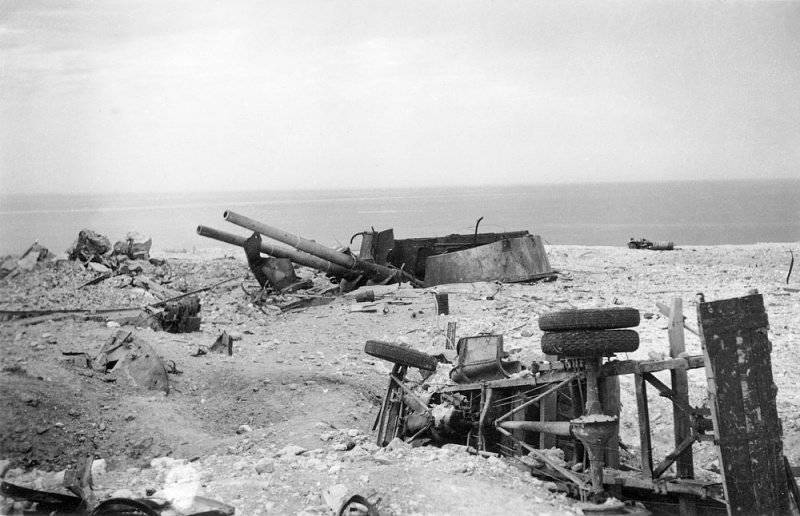
Destroyed turret gun installation №1 35-th coastal battery of Sevastopol.
Information